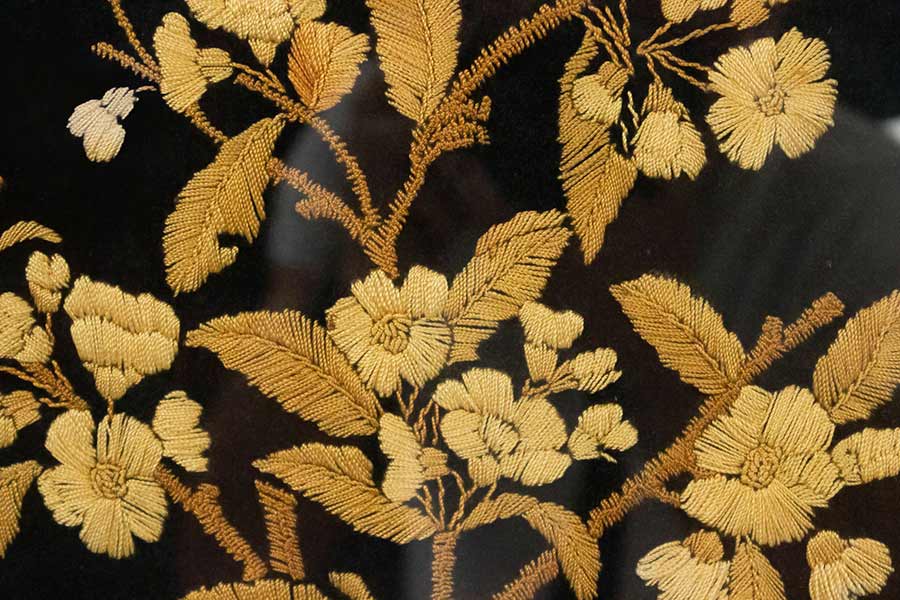Victorian embroidery is a type of embroidery that was popular during the Victorian era – the late 1800s into the early 1900s. Like the Victorians themselves, Victorian embroidery and sewing was about both function and form – it was both plan and fancy. During the hard-laboring 19th century, it was rare for women to have any idle time on their hands. Spare blocks of time were often dedicated to sewing. Standard (“plain”) sewing was executed for the purposes of simple repairs – mending tears, letting out waistbands, raising or lowering hems, etc. And extravagant (“fancy”) embroidery — as well as crocheting and knitting — was for the simple purpose of adding art and beauty to functional items. A skilled young woman marketable for marriage would not only be able to deploy basic sewing skills to assist her household with its clothing and linen needs; she would also be able to decorate pillows and curtains, and perhaps even create a few fun and stylish pieces for herself. Some women, as the magazine Harper’s Bazaar reported in 1873, could even turn “the frivolity of fancy-work” into “excellent profit”, which in turn gave these typically sheltered and patriarchy-restricted women some additional spending freedoms.
She Can Sew Anything; Sew Can You
Traditional Victorian ladies were raised to sew not just standard, function-meeting items like blouses, skirts, and trousers; they could also create a variety of petticoats, corsets, garters, even reticules and other types of handbags and luggage items. Hand-sewn and embroidered baby clothing was also quite popular; in fact, it is from the Victorian era that layettes became so popular. Household items such as doilies, pillows, curtains, other linens, and even pet accessories were also popular hand-sewn items. It was a skilled Victorian lady who could provide all of her home’s clothing and linen needs herself, though plenty paid friends to add Victorian embroidery and specialty crocheted and knitted embellishments. Some women made quite the profit from marketing their sewing and embroidering skills – the same 1873 Harper’s Bazaar article wrote at length about a widow who owned her city house outright and was able to independently support herself and her children, all on the income earned by plying a needle.
More Than Just a Skill
While Victorian women taught their daughters, sisters, and other female relatives basic sewing skills to ensure they could practically supplement their household with in-house repairs, middle and upper class women in the market for marriage would set out to specifically learn the tricky talents of Victorian embroidery – the so-called “fancy work” that added beautiful decorations to clothing and linens. Fancy work was taught at home and even at school, and towards the end of the 1800s women’s colleges were even offering Victorian sewing and Victorian embroidery classes. Once married, these middle and upper class women would delegate the function-only work of basic sewing and repairs to maids, and utilize their own hands for fancier work.
Lower class women too learned the skill of Victorian sewing and embroidery; however they learned it at the expense of shorting themselves on opportunities for learning reading, writing, and arithmetic. Furthermore, many lower class female students were required to learn and deploy Victorian sewing and embroidery skills as a way of paying for their room and board at school.
While it’s true that the age of the Industrial Revolution ushered in the sewing machine, Victorian embroidery was still a trade to be executed by hand. To this day, embroidery is best done by hand, rather than machine.
More Insights from Your Austin Embroidery Experts
If you’re interested in learning more about the history of this fascinating art, be sure to check out our previous article on a brief history of embroidery. You may also be interested in our post on the basics of hand-embroidery, which details the historical process of embroidering fabrics using hand stitching. Finally, if you need personalized tips or recommendations for your next embroidery project, don’t hesitate to contact the experts at Rivercity Screenprinting & Embroidery in Austin!

